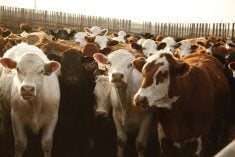Photographs of bison roaming the prairie and grazing grass portray to consumers an image of how the animals are raised and their food is produced.
But would they have the same perception if the bison industry used feedlot images in its marketing campaign, asked animal welfare professor Ed Pajor.
People have expectations about how animals are raised, and those are driven by agricultural mythology.
To many, the story of Old McDonald’s Farm still applies. Pajor, from the University of Calgary’s veterinary faculty, told the Canadian Bison Association convention of a request to a farmer from a Grade 2 teacher who was bringing students to his farm: Would he please wear his uniform of straw hat and overalls.
Read Also

Growth plates are instrumental in shaping a horse’s life
Young horse training plans and workloads must match their skeletal development. Failing to plan around growth plates can create lifelong physical problems.
Perception is reality for consumers so far removed from the farm, he said.
“Two to three percent have a connection to agriculture,” he noted.
They don’t know what a family farm looks like but they expect it to be a certain way.
Bison in feedlots likely don’t fit that image.
Pajor said while there are extremists on both sides of the political debate around animal rights; most customers of bison producers are likely in the middle.
They eat meat but they also expect a certain standard of care is met by producers.
“Do you know your clientele and their values?” he asked.
One producer pointed out that much of the problem is the attribution of human qualities to animals in movies and books.
Pajor calls it the Disneyfication of animals.
“How are you going to deal with it, because that’s what you’re selling into,” he said.
The bison industry hasn’t come under the scrutiny that others have but the day could come.
Last week an American television program aired footage secretly taped at several locations of an egg supplier to McDonald’s restaurants. The footage showed cruelty to the birds, and the chain dropped one of its largest suppliers as a result.
Pajor said large buyers such as restaurants and grocers have adopted certain standards at least in part because of pressure from certain groups.
People for the Ethical Treatment of Animals actually owns shares in McDonald’s and can attend annual meetings and influence the company’s choices.
“It is now a show me, don’t just tell me, world,” Pajor said.
People all along the food chain have to be able to demonstrate they are following the rules, he said.















